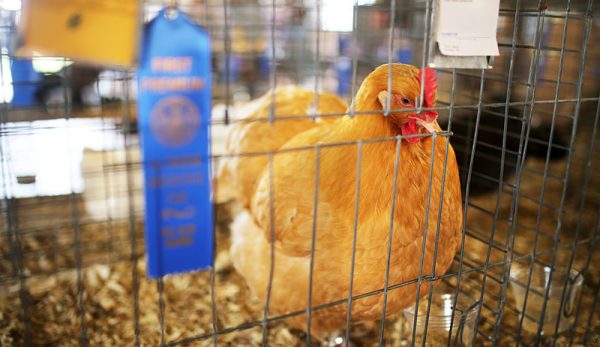
Sometimes I get so involved tackling questions from readers and social-media followers that I forget to interact with poultry people closer to home. Or in my home. I was diligently at work on a photography project when my phone beeped. It was a one-word text from my husband, Jae: Quality?
There was absolutely no context, so I puzzled over it for a few seconds, then went back to work. A few minutes later, “Well???” popped up in my text notifications. I briefly wondered if he somehow was questioning what I was doing on Photoshop. I typed back, “Well what??” and resumed editing photos, only to have my Echo blast at me, “Ana, come up here!” moments later.
I trooped upstairs to my husband’s office, where he sat, frowning at one of his monitors. Curious, I peeked over his shoulders. An eBay listing for hatching eggs occupied the screen. I was a bit baffled as to why Jae would be looking at hatching eggs, since I’m the one that manages our poultry farm. Jae then jabbed a finger at the listing and demanded, “What the (bleep) do they mean by pet quality?”
Sometimes I mistakenly assume that, since we co-own our poultry farm, Jae also shares my depth of knowledge regarding all things fowl. In reality, he builds and repairs the coops, finances the operation, and has no clue what any of our birds’ names might be. At least he can tell duck from chicken from turkey. He gets a little miffed when I talk about CJ’s antics or that Azure’s neck needs Blu Koting, since he has no idea whom I’m discussing.
I can only imagine what he thought “pet quality” meant.
The Definition of Quality
Competitive breeders of chickens, however, fully comprehend the meaning of quality. Quality has nothing to do with how many eggs a hen lays or how succulent a broiler’s meat might be.
Quality refers to only one thing: how closely a bird aligns with its breed’s Standards of Perfection. Published by the American Poultry Association, the Standards of Perfection detail every last trait a bird must display to be considered a true example of its breed. Height, weight, carriage, body shape, feather pattern, feather color, skin color, shank color, eye color, beak color, earlobe color, type of comb, even number of toes—all of these characteristics and more are listed for each recognized breed and variety.
Read more: Check out these 5 tips for effective poultry showmanship.
Show Quality
A bird that meets most—or, rarely, all—of the Standards set for its breed is considered to be show quality. Show-quality birds are the most highly prized poultry specimens, as they present well in competition and are most likely to win top prizes at poultry exhibitions.
Understandably, show-quality birds also fetch the highest prices amongst fowl fanciers. Even show-quality chicks can cost quite a bit, going for five, six or seven times the price of a regular chick … or even higher! If you are looking to invest in show-quality birds, be aware that most reputable breeders will not sell show-quality hatching eggs because they can only rate the chicks once they have hatched and fluffed out.
Breeder Quality
Those wishing to raise a specific breed of bird—for fun, for profit or to aid in conservation efforts—can rely on breeder-quality chicks and/or adults to get their flock underway. Breeder-quality birds have slight differences from show-quality birds. These diversions are typically indiscernible to all but the practiced poultry expert eye.
A couple of toenails might be the wrong color, the comb might be too small, or the wattles the wrong shade of red. Imperfections like these would disqualify birds from competition. But they are acceptable in birds designated to breed and propagate the variety.
Yes, it would be preferable for the near-perfect show-quality birds to serve as sires and dams for future flocks, since improving the breed is the ultimate goal of any poultry keeper. Breeder-quality birds are more wallet friendly, however. And it is quite possible that, by introducing different bloodlines, breeder-quality birds may produce show-quality birds in future generations.
Read more: Prepare your chicken for the fair with these 7 tips!
Pet Quality
Pet-quality birds are your run-of-the-mill, everyday bird, the kind sold by hatcheries, feed stores and by most backyard breeders.
There’s absolutely nothing wrong with chickens with this quality ranking. They lay, scratch, forage, and behave just like other birds of their breed. They simply don’t have the wow factor that show-quality chickens display or even the caliber that breeder-quality birds have.
In fact, most show-quality poultry breeders would cull pet-quality chickens from their flocks, viewing these as a detriment to the breed. Fortunately, most backyard-flock and hobby-farm owners don’t select their chickens by the Standards of Perfection but by other factors, such as egg production, weather hardiness and docility.
If you are raising a microflock or a small flock for eggs, meat, or companionship, pet-quality poultry is just right for you.
As for Jae, I think he tuned me out once I explained that there are three key qualities when it comes to domestic poultry. I suppose it’s only fair, since I’m sure I likewise went glassy eyed when he tried to explain the choices of wood for our coops. We’ll each stick to what we know best.




